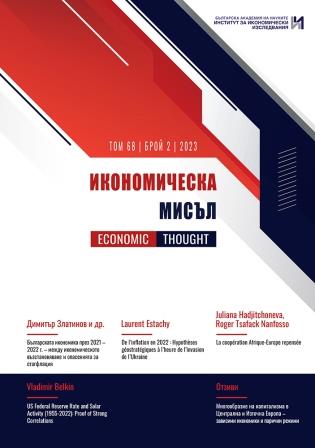De l’inflation en 2022 : Hypothèses géostratégiques à l’heure de l’invasion de l’Ukraine
2022 Inflationary trend: The geostrategic hypotheses in the era of Ukraine’s invasion
Author(s): Laurent EstachySubject(s): Economy, National Economy, Business Economy / Management
Published by: Институт за икономически изследвания при Българска академия на науките
Keywords: inflation; macroeconomics; international finance; economic history; international relations
Summary/Abstract: Are the root causes of the current inflationary tensions geostrategic in nature? A global perspective of the major geostrategic issues pitting the United States and its Western allies against China and Russia, for the most part, is not only necessary but unavoidable. Is a clash of blocks now at work with the Russian invasion of Ukraine? These tensions are not only of a military nature but, above all, an economic, commercial and financial one. Monetary and budgetary responses, particularly those implemented in the United States, must be placed in this geostrategic context, as they form, by their magnitude, developments that have not been seen since the Second World War. In this respect, the guidelines announced in August 2020 by Jerome Powell, President of the US Federal Reserve Bank, constitute a revolution in monetary policies, the importance of which was not immediately perceived: after 40 years’ fighting against inflation since Paul Volker in 1979, the FED deliberately wished for a return to inflation and acted accordingly. One hypothesis adopted here is that the debt generated in part by the repeated trade deficits suffered by the United States in its “systemic” relations with China, especially since 2001 and its acceptance into the World Trade Organization, can only be reduced – in the minds of American leaders – by a fiscal-monetary “policy mix” which must lead to strong growth and moderate inflation just as in the years following the Second World War. The other two debt reduction options are austerity policies and default: the former have never had priority in the United States, while the latter is not possible because the US dollar must remain the world’s currency. The paper’s contents resituate the rise of inflationary pressures on goods and services observed in 2021 and 2022 within the framework of the systemic relations (economic, commercial, financial, etc.) that have developed between the United States and China since the early 1980s. With Russia’s invasion of Ukraine in February 2022, and against the background of a “new type” of relationship between Russia and China, should the economic and financial globalization phenomena of the past 40 years be called into question?
Journal: Икономическа мисъл
- Issue Year: 2023
- Issue No: 2
- Page Range: 163-194
- Page Count: 32
- Language: French

